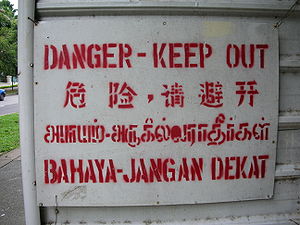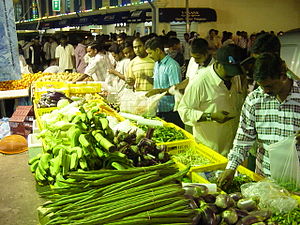 |
| The Singapore Skyline v3 (Photo credit: Wikipedia) |
 |
| Quadrilingual warning sign in Singapore. The text is in the four official languages of Singapore, from top to bottom: English, Chinese, Tamil and Malay. (Photo credit: Wikipedia) |
 |
| Foreign construction workers at Little India. (Photo credit: Wikipedia) |
-----
Jan 10, 2013
by Chi Shing Hui
While I agree with the writer, in "Immigration is not long-term solution" (Jan 7), that our heritage and identity are priceless and should be preserved, the future well-being of the whole nation should not be paid as the price.
The Asian and global markets have become increasingly competitive.
When Singapore's annual birth rate has remained at low levels, letting in immigrants is one of the crucial approaches to ensure a healthy growth in the workforce so that Singapore can maintain its competitive edge.
We frequently hear voices about immigrants taking away jobs from locals. We should let the market take its course, though.
All things being equal, I do not believe that most employers would hire a foreigner over a Singaporean.
Yet, when a local and a foreign candidate ask for significantly different pay packages, this may become a major factor in hiring decisions.
This is why Singaporeans should strive to compete with foreigners, not on pay but more in terms of skills and productivity. This is also a message the Government is promulgating.
Reserving jobs for Singaporeans may end up with employers paying more to fill positions. Most, if not all, employers would pass the increased costs onto consumers, leading to inflation and an eventual drop in Singapore's overall competitiveness among its peers.
I recently read news of cleaning work not done in public areas and delays in construction projects owing to insufficient numbers of workers. I suspect the cut in the ratio of foreign workers to local workers may be one of the causes.
Last but not least, regarding the writer's question of what kind of legacy "we wish to pass to our children", I may not know all the answers, but a huge ageing population that cannot be supported by a diminishing workforce is surely not one of them.
-----
Taken from TODAYOnline.com; source article is below:
Compete with foreigners in terms of skills, not pay










































